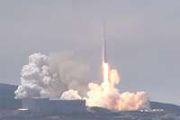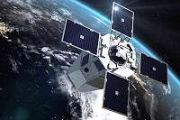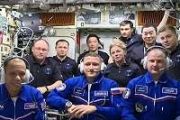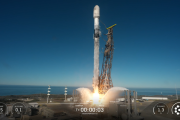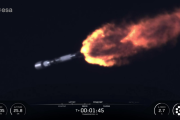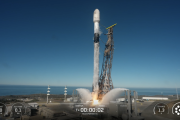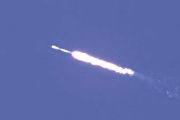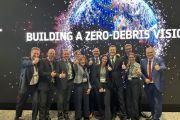
Copernical Team
SpaceX sends up more Starlink satellites from California
 SpaceX launched another batch of 27 Starlink V2 Mini satellites into low-Earth orbit on Friday from California.
The Falcon 9 flight was delayed from Thursday night. No reason was given for the scrubbing.
The rocket lifted off 3:32 p.m. PDT from Vandenberg Space Force Base's Pad 4E.
A little more than eight minutes after liftoff, the first stage booster landed on the drones
SpaceX launched another batch of 27 Starlink V2 Mini satellites into low-Earth orbit on Friday from California.
The Falcon 9 flight was delayed from Thursday night. No reason was given for the scrubbing.
The rocket lifted off 3:32 p.m. PDT from Vandenberg Space Force Base's Pad 4E.
A little more than eight minutes after liftoff, the first stage booster landed on the drones S.Africa moves to ease black empowerment law under Starlink pressure
 South Africa's government is moving towards easing its black ownership laws in the telecoms sector - a policy change that would smooth the way for Elon Musk's Starlink to enter the local market.
The directive came days after South African President Cyril Ramaphosa met his US counterpart Donald Trump for tense talks on deteriorating ties between the two countries.
Telecoms companies oper
South Africa's government is moving towards easing its black ownership laws in the telecoms sector - a policy change that would smooth the way for Elon Musk's Starlink to enter the local market.
The directive came days after South African President Cyril Ramaphosa met his US counterpart Donald Trump for tense talks on deteriorating ties between the two countries.
Telecoms companies oper Doubt cast on claim of 'hints' of life on faraway planet
 When astronomers announced last month they might have discovered the most promising hints of alien life yet on a distant planet, the rare good news raised hopes humanity could soon learn we are not alone in the universe.
But several recent studies looking into the same data have found that there is not enough evidence to support such lofty claims, with one scientist accusing the astronomers
When astronomers announced last month they might have discovered the most promising hints of alien life yet on a distant planet, the rare good news raised hopes humanity could soon learn we are not alone in the universe.
But several recent studies looking into the same data have found that there is not enough evidence to support such lofty claims, with one scientist accusing the astronomers After two setbacks, SpaceX could try to launch massive Starship next week
This request seems a bit unusual, so we need to confirm that you're human. Please press and hold the button until it turns completely green. Thank you for your cooperation!
Press and hold the button
If you believe this is an error, please contact our support team.
185.132.36.159 : 761025ca-08f3-4d95-be77-6146a2ac
NASA-French Satellite Spots Large-Scale River Waves for First Time
 The SWOT mission captured the flood waves, which stretched from 47 to 166 miles long, as they traveled down rivers in Montana, Texas, and Georgia.
In a first, researchers from NASA and Virginia Tech used satellite data to measure the height and speed of potentially hazardous flood waves traveling down U.S. rivers. The three waves they tracked were likely caused by extreme rainfall and by a
The SWOT mission captured the flood waves, which stretched from 47 to 166 miles long, as they traveled down rivers in Montana, Texas, and Georgia.
In a first, researchers from NASA and Virginia Tech used satellite data to measure the height and speed of potentially hazardous flood waves traveling down U.S. rivers. The three waves they tracked were likely caused by extreme rainfall and by a Deep mantle carbon flow influences diamond formation and craton stability
 A recent study led by scientists at the Guangzhou Institute of Geochemistry of the Chinese Academy of Sciences (GIG-CAS), in collaboration with international partners, uncovers how deeply subducted carbonates reshape the Earth's mantle chemistry, influencing both diamond formation and the evolution of cratonic lithosphere.
Using high-pressure experiments that simulate depths from 250 to 66
A recent study led by scientists at the Guangzhou Institute of Geochemistry of the Chinese Academy of Sciences (GIG-CAS), in collaboration with international partners, uncovers how deeply subducted carbonates reshape the Earth's mantle chemistry, influencing both diamond formation and the evolution of cratonic lithosphere.
Using high-pressure experiments that simulate depths from 250 to 66 Citizen scientists asked to identify clouds in satellite data for climate research
 CloudCatcher, a citizen science program developed by STFC RAL Space, is inviting the public to help improve the accuracy of cloud detection in satellite imagery. The project plays a vital role in enhancing how scientists measure Earth's surface temperatures from space by verifying when clouds obstruct the satellite's view.
This latest version of CloudCatcher builds on the success of a 2020
CloudCatcher, a citizen science program developed by STFC RAL Space, is inviting the public to help improve the accuracy of cloud detection in satellite imagery. The project plays a vital role in enhancing how scientists measure Earth's surface temperatures from space by verifying when clouds obstruct the satellite's view.
This latest version of CloudCatcher builds on the success of a 2020 Microsoft AI weather forecast faster, cheaper, truer: study
 Microsoft has developed an artificial intelligence (AI) model that beats current forecasting methods in tracking air quality, weather patterns, and climate-addled tropical storms, according to findings published Wednesday.
Dubbed Aurora, the new system - which has not been commercialised - generated 10-day weather forecasts and predicted hurricane trajectories more accurately and faster th
Microsoft has developed an artificial intelligence (AI) model that beats current forecasting methods in tracking air quality, weather patterns, and climate-addled tropical storms, according to findings published Wednesday.
Dubbed Aurora, the new system - which has not been commercialised - generated 10-day weather forecasts and predicted hurricane trajectories more accurately and faster th Week in images: 19-23 May 2025

Week in images: 19-23 May 2025
Discover our week through the lens
Earth from Space: Alakol, the multicoloured lake
 Image:
Lake Alakol in eastern Kazakhstan is featured in this radar image captured by Copernicus Sentinel-1.
Image:
Lake Alakol in eastern Kazakhstan is featured in this radar image captured by Copernicus Sentinel-1. 

